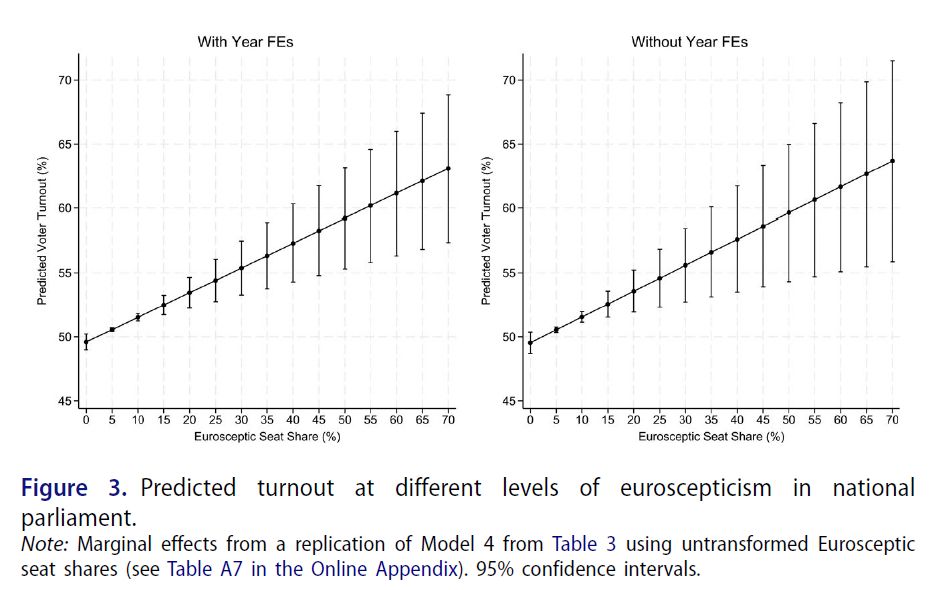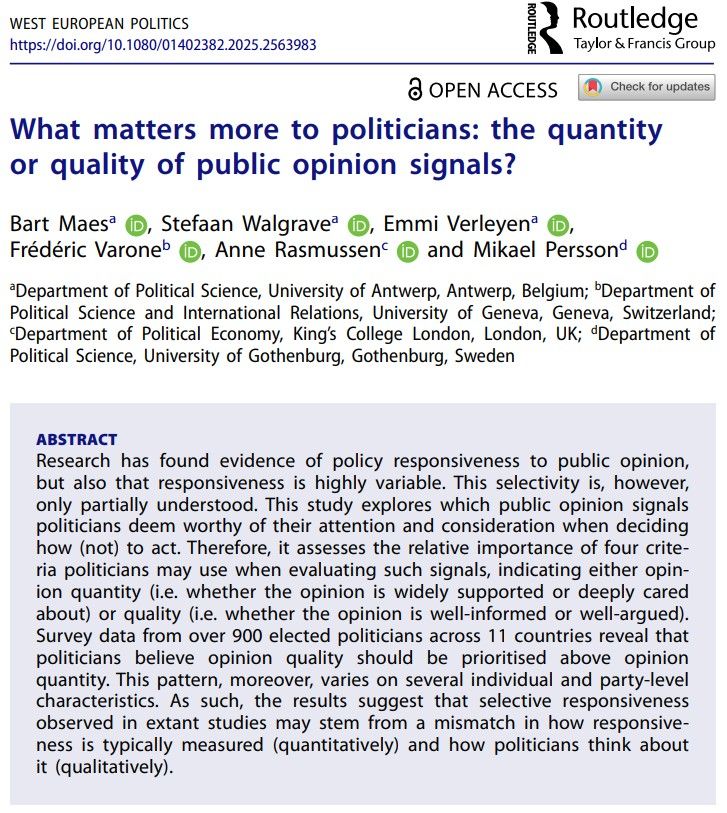"Updating cleavage theory for the twenty-first century" by @dpzollinger.bsky.social & @davidattewell6.bsky.social
doi.org/10.1080/0140...

by Klaus H. Goetz — Reposted by: Robert Huber
👉 Discover how welfare state size moderates the effect of cyclical unemployment in the latest study by Ivan Petrúšek & Kristyna Basna
doi.org/10.1080/0140...



Reposted by: Klaus H. Goetz, Vincent Tiberj, Swen Hutter
www.tandfonline.com/doi/full/10....

Its papers explore the foundations of the cleavage pitting new left against radical right parties, and how it compares to the classic cleavages of Lipset & Rokkan:
🧵⬇️
"Women’s descriptive representation in multi-level political systems: (almost) no pyramids found"
The new research note by @adamgendzwill.bsky.social & Stanislaw Mazur
doi.org/10.1080/0140...




by Klaus H. Goetz — Reposted by: Mikael Persson
Find out in the new article by @bart-maes.bsky.social Stefaan Walgrave Emmi Verleyen Frédéric Varone @annerasmussen.bsky.social & @professormpersson.bsky.social
doi.org/10.1080/0140...




by Klaus H. Goetz — Reposted by: Simon Hix, Robert Huber, Simon Usherwood
@filipkostelka.bsky.social & @evakrejcova.bsky.social find that it's the strength of Eurosceptic parties at the national level. The more seats they hold in national parliament, the more mobilizing the EP election is
doi.org/10.1080/0140...




Reposted by: Klaus H. Goetz, Ruth Dassonneville, Anne Rasmussen

"Easier said than done: the European Parliament’s entrepreneurs in the treaty change discourse"
by @karolinaboronska.bsky.social & @krotky.bsky.social
🔗 doi.org/10.1080/0140...




by Klaus H. Goetz — Reposted by: Davide Vampa
👉 Regional elections across Western Europe are becoming more unstable, often mirroring national turbulence. But the link weakens where regionalist parties are strong, institutions are powerful, or regions are more prosperous.
🔗 doi.org/10.1080/0140...




Reposted by: Klaus H. Goetz
by Davide Vampa — Reposted by: Klaus H. Goetz
National instability is often reflected in regional arenas - but regional parties, institutional autonomy & economic prosperity can act as buffers
Full article (open-access) here ⬇️
www.tandfonline.com/doi/full/10....

by Davide Vampa — Reposted by: Klaus H. Goetz, Davide Vampa
📄 From nations to regions: electoral volatility in European multi-level politics
Open access👉 doi.org/10.1080/01402382.2025.2557768
National politics in Europe is growing more electorally unstable - does this volatility also reach the regions? Thread 🧵

Reposted by: Klaus H. Goetz
'Lipset and Rokkan meet data': a 🧵on our study (with Bruno Marino) on the electoral structuring of traditional cleavages (1870–1967) across 17 Western European countries 👇
Read the full article (open access):
www.tandfonline.com/doi/full/10....
Reposted by: Klaus H. Goetz, Jochen Müller, Robert Huber , and 1 more Klaus H. Goetz, Jochen Müller, Robert Huber, Mirya R. Holman

by Uwe Puetter — Reposted by: Klaus H. Goetz
@cterranova.bsky.social
www.tandfonline.com/doi/full/10....
by Klaus H. Goetz — Reposted by: Klaus H. Goetz, Jochen Müller, Marc Debus , and 3 more Klaus H. Goetz, Jochen Müller, Marc Debus, Robert Huber, Mirya R. Holman, Thomas M. Meyer
"The sound of party competition: how applause reflects unity, disagreement, and the electoral cycle in parliaments"
by @ankuepfer.bsky.social @jocmuel.bsky.social & @pluggedchris.bsky.social
doi.org/10.1080/0140...




Lots of superb research on:
👉different parties
👉social democracy
👉support for democracy
👉regional coalitions
👉populism & radical right parties
👉group appeals
👉elections: Belgium 2024
www.tandfonline.com/toc/fwep20/4...

by Klaus H. Goetz — Reposted by: Mikael Persson
"Ideological bias in policy implementation: public opinion and policy outcomes in 43 democracies"
Research Note by @professormpersson.bsky.social & Anders Sundell
doi.org/10.1080/0140...




by Klaus H. Goetz — Reposted by: Klaus H. Goetz
"How we think about the political stances of others: evidence on projection from Canada, Germany, and the UK"
by @seonghuilee.bsky.social & @avkevins.bsky.social
doi.org/10.1080/0140...




Both ideological & partisan divides reduce citizens’ ability to hold leaders accountable.
🔗 Read more: doi.org/10.1080/0140...




by Klaus H. Goetz — Reposted by: Klaus H. Goetz
‼️Findings challenge assumptions about growing executive centralization and trends toward presidentialism ‼️
doi.org/10.1080/0140...




"Communicating a common front: mainstream party rhetoric and affective polarisation towards the radical right"
by @markuskollberg.bsky.social & @ivobantel.bsky.social
doi.org/10.1080/0140...




by Klaus H. Goetz — Reposted by: Klaus H. Goetz, Robert Huber, Robert Klemmensen
doi.org/10.1080/0140...




by Klaus H. Goetz — Reposted by: Swen Hutter
"Cleavage theory meets civil society: a framework and research agenda"
by @mierkezat.bsky.social @eborbath.bsky.social & @swenhutter.bsky.social
doi.org/10.1080/0140...



"Stuck on the stairway of change: the EU’s enlargement and security and defence policies post 2022"
by @antoanetadl.bsky.social Seda Gürkan & Joachm Koops
doi.org/10.1080/0140...


"Pathways to politics: a sequence analysis of political apathy and involvement"
by @sjungkunz.bsky.social l & Paul Marx
doi.org/10.1080/0140...



